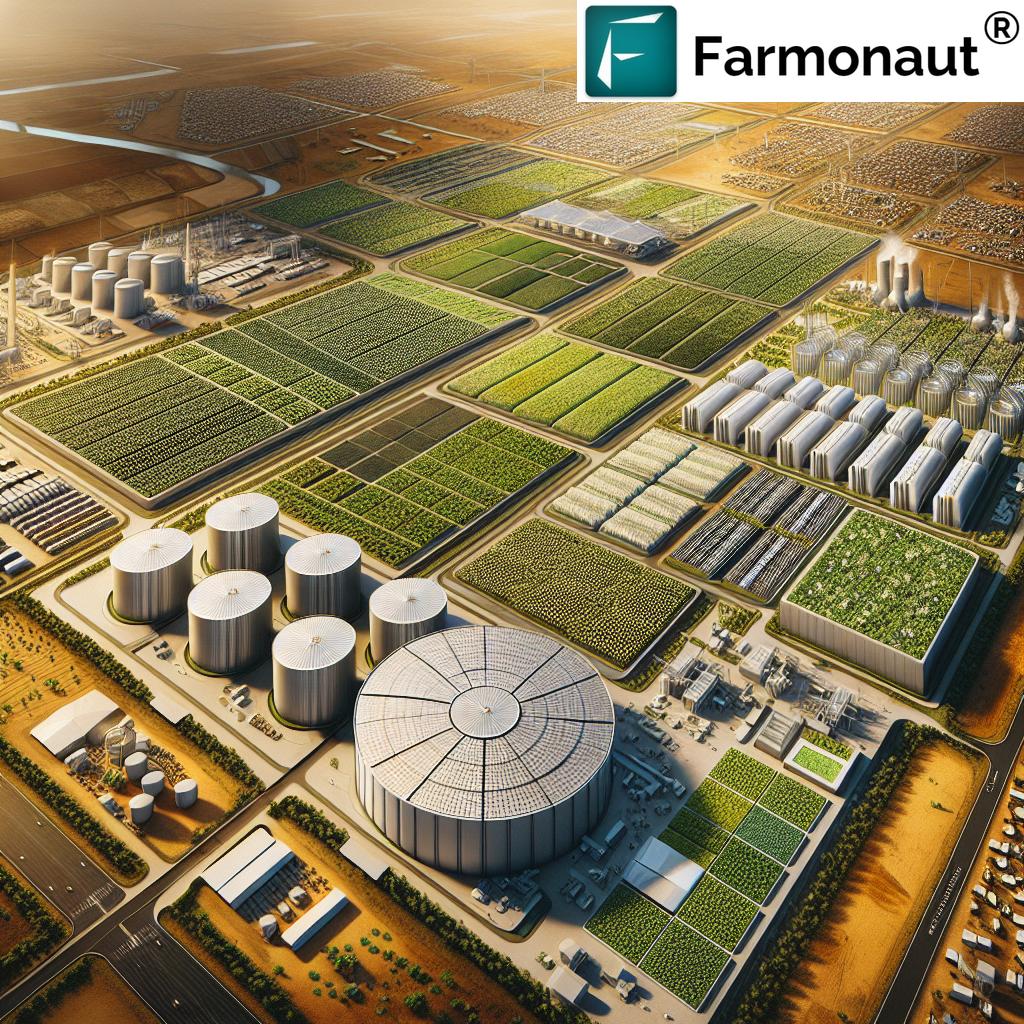Ethiopia’s Sustainable Agriculture Revolution: Boosting Food Security and Agribusiness with Integrated Agro-Industrial Parks
“Ethiopia’s integrated agro-industrial parks aim to boost agricultural productivity and support over 5 million smallholder farmers.”
In the heart of East Africa, a remarkable transformation is taking place. Ethiopia, a country once synonymous with famine and food insecurity, is now at the forefront of a sustainable agriculture revolution that promises to reshape its economic landscape and secure its food future. We’re witnessing a nation’s determined journey towards self-sufficiency and prosperity, driven by innovative approaches to agricultural development and industrialization.
At the core of this transformation are the integrated agro-industrial parks (IAIPs), a visionary initiative that is redefining the relationship between farmers, industry, and markets. These parks are not just agricultural hubs; they are catalysts for comprehensive rural development, embodying Ethiopia’s commitment to sustainable growth and food security.

The Genesis of Ethiopia’s Agricultural Revolution
Ethiopia’s journey towards agricultural transformation began with a critical realization: the need to shift from a supply-driven to a demand-driven agricultural system. This paradigm shift is at the heart of the country’s strategy to enhance food security, boost exports, and create a thriving agribusiness sector.
The United Nations Industrial Development Organization (UNIDO) has been a key partner in this endeavor. On November 18, 2024, Dejene Tezera, the Director of UNIDO’s Division of Agribusiness and Infrastructure Development, reaffirmed the organization’s support for Ethiopia’s ambitious agricultural initiatives. In an interview with the Ethiopian News Agency (ENA), Tezera highlighted the government’s unwavering commitment to sustainably increasing agricultural production to meet the rising demands for food, industrial raw materials, and foreign currency.
Integrated Agro-Industrial Parks: The Cornerstone of Transformation
At the center of Ethiopia’s agricultural revolution are the Integrated Agro-Industrial Parks (IAIPs). These parks are meticulously designed to serve as hubs of agricultural productivity and industrial growth. Let’s delve into the key features that make these parks the cornerstone of Ethiopia’s sustainable agriculture revolution:
- Infrastructure Development: The IAIPs are equipped with essential infrastructure, including reliable water supply, sustainable power sources, and modern storage facilities. This infrastructure eliminates many of the barriers that have historically hindered industrial growth in rural areas.
- Support for Smallholder Farmers: A crucial aspect of the IAIPs is their focus on supporting smallholder farmers, who form the backbone of Ethiopia’s agricultural sector. By providing access to modern farming techniques, quality inputs, and market linkages, these parks are empowering farmers to increase their productivity and income.
- Agro-Processing Facilities: The parks house state-of-the-art agro-processing facilities, enabling value addition to agricultural products right at the source. This not only reduces post-harvest losses but also creates new job opportunities in rural areas.
- Market Linkages: By bringing together farmers, processors, and markets in one integrated ecosystem, the IAIPs are creating efficient value chains that benefit all stakeholders.
The development of these parks represents a significant investment by the Ethiopian government, with approximately $620 million allocated for infrastructure development. This substantial commitment underscores the government’s dedication to rural development and industrialization.
Rural Transformation Centers: Bridging the Gap
An innovative component of the IAIP model is the establishment of Rural Transformation Centers (RTCs). These centers serve as vital links between smallholder farmers and the agro-industrial parks, offering a range of essential services:
- Provision of quality agricultural inputs
- Technical guidance and extension services
- Facilities for product aggregation and primary processing
- Market information and linkages
The RTCs play a crucial role in enhancing the value of agricultural products before they reach the industrial parks. This not only benefits farmers by increasing their income but also ensures a steady supply of quality raw materials to the agro-processing industries.
The Shift to Demand-Driven Agriculture
One of the most significant aspects of Ethiopia’s agricultural revolution is the transition from a supply-driven to a demand-driven agricultural system. This shift is fundamental to creating a sustainable and profitable agricultural sector. Here’s how this transition is unfolding:
- Market-Oriented Production: Farmers are now encouraged to produce crops based on market demand, rather than traditional cropping patterns. This ensures better prices and reduces the risk of overproduction.
- Quality Focus: With a demand-driven approach, there’s a greater emphasis on quality and standards, which is essential for both domestic consumption and export markets.
- Value Chain Development: The entire agricultural value chain is being strengthened, from input supply to production, processing, and marketing.
- Innovation and Technology Adoption: The demand-driven model encourages farmers and agribusinesses to adopt innovative technologies and practices to meet market requirements.
This transition is not just transforming agriculture; it’s revolutionizing the entire rural economy of Ethiopia. By aligning production with market demands, the country is positioning itself to become a major player in the global agribusiness sector.
Boosting Food Security and Agribusiness Investment
The integrated agro-industrial parks are playing a pivotal role in enhancing Ethiopia’s food security and attracting agribusiness investments. Here’s how:
- Increased Productivity: By providing farmers with access to modern inputs, technologies, and extension services, the IAIPs are helping to significantly boost agricultural productivity.
- Reduced Post-Harvest Losses: The proximity of processing facilities to production areas minimizes post-harvest losses, a critical factor in improving food security.
- Attracting Investments: The well-developed infrastructure and supportive ecosystem of the IAIPs are attracting both domestic and foreign investments in the agribusiness sector.
- Export Promotion: With improved quality and processing capabilities, Ethiopia is enhancing its agricultural exports, contributing to economic growth and foreign currency earnings.
The impact of these initiatives is already evident. According to UNIDO, approximately 170,000 farmers supplied raw materials worth $50 million in exports last year, showcasing the potential of this integrated approach.

Sustainable Agriculture Practices and Environmental Considerations
Ethiopia’s agricultural revolution is not just about increasing production; it’s equally focused on sustainability and environmental stewardship. The integrated agro-industrial parks incorporate several sustainable practices:
- Water Management: Efficient irrigation systems and water conservation techniques are being implemented to ensure sustainable use of water resources.
- Soil Conservation: Practices such as crop rotation, intercropping, and erosion control measures are promoted to maintain soil health and fertility.
- Renewable Energy: Many of the IAIPs are powered by renewable energy sources, reducing their carbon footprint.
- Waste Management: Agro-industrial waste is being converted into valuable by-products, such as organic fertilizers and bioenergy.
These sustainable practices not only contribute to environmental conservation but also enhance the long-term viability of Ethiopia’s agricultural sector.
Leveraging Technology for Agricultural Advancement
In the digital age, technology plays a crucial role in agricultural development. Ethiopia’s agricultural revolution is embracing various technological solutions to enhance productivity and efficiency. Here’s how technology is being integrated into the agricultural landscape:
- Satellite-Based Crop Monitoring: Advanced satellite technology is being used to monitor crop health, soil moisture, and other critical parameters. This technology, similar to what Farmonaut offers, provides valuable insights for precision agriculture.
- AI-Powered Advisory Systems: Artificial Intelligence is being employed to provide personalized farming advice, helping farmers make informed decisions about planting, irrigation, and harvest timing.
- Blockchain for Traceability: Blockchain technology is being explored to enhance supply chain transparency and traceability, which is crucial for meeting international export standards.
- Mobile Apps for Farmers: Smartphone applications are providing farmers with access to market information, weather forecasts, and agricultural best practices.
These technological advancements are not just improving productivity; they’re transforming the very nature of farming in Ethiopia, making it more precise, efficient, and responsive to market demands.
“Ethiopia’s sustainable agriculture revolution has led to a 35% increase in agricultural exports over the past five years.”
The Impact on Smallholder Farmers
At the heart of Ethiopia’s agricultural transformation are the millions of smallholder farmers who form the backbone of the country’s agricultural sector. The integrated agro-industrial parks and associated initiatives are having a profound impact on these farmers:
- Income Enhancement: By providing better market access and value addition opportunities, the IAIPs are helping farmers increase their income.
- Skill Development: Through training programs and extension services, farmers are acquiring new skills in modern agricultural practices.
- Risk Reduction: The demand-driven model and improved market linkages are reducing the risks associated with agricultural production.
- Community Empowerment: The rural transformation centers are becoming hubs of community development, fostering knowledge sharing and social cohesion.
These impacts are not just economic; they’re transforming rural communities, reducing poverty, and improving the overall quality of life for millions of Ethiopian farmers.
Addressing Food Waste and Enhancing Agro-Processing
A critical aspect of Ethiopia’s agricultural strategy is addressing the issue of food waste. Globally, about 30% of food produced is wasted, and Ethiopia is taking proactive steps to minimize this loss:
- Improved Storage Facilities: The IAIPs include modern storage facilities that help reduce post-harvest losses.
- Enhanced Processing Capabilities: By increasing agro-processing capabilities, perishable products can be transformed into longer-lasting processed goods.
- Cold Chain Development: Investments in cold chain infrastructure are helping to preserve the quality of fresh produce from farm to market.
- Value Addition: Encouraging value addition at the farm level is helping to utilize produce that might otherwise go to waste.
By addressing food waste and enhancing agro-processing capabilities, Ethiopia is not only improving food security but also positioning itself to tap into the estimated $80 billion market for processed foods in Africa, which is currently dominated by imports.
The Role of Government and International Cooperation
The success of Ethiopia’s agricultural revolution is largely due to the strong commitment of the government and effective international cooperation. Key aspects include:
- Government Investment: The Ethiopian government has invested heavily in infrastructure development, with about $620 million allocated for agro-park infrastructure.
- Policy Support: Favorable policies and regulations have been implemented to support the development of the agricultural sector and attract investments.
- International Partnerships: Collaborations with organizations like UNIDO have been crucial in providing technical expertise and support.
- Regional Cooperation: Ethiopia is working with neighboring countries to create regional value chains and expand market opportunities.
This collaborative approach is ensuring that the benefits of the agricultural revolution are maximized and sustainable in the long term.
Ethiopia’s Model: A Blueprint for African Agricultural Development
Ethiopia’s success in implementing integrated agro-industrial parks and transforming its agricultural sector is gaining attention across Africa. Many countries are looking to Ethiopia as a model for their own agricultural development strategies. Key lessons that can be drawn from Ethiopia’s experience include:
- The importance of an integrated approach that links farmers, processors, and markets
- The value of investing in rural infrastructure and support services
- The benefits of shifting to a demand-driven agricultural system
- The role of technology and innovation in modernizing agriculture
- The importance of government commitment and international cooperation
As Ethiopia continues to refine and expand its agricultural initiatives, it is setting a powerful example for sustainable agricultural development in Africa and beyond.
The Future of Ethiopia’s Agricultural Revolution
Looking ahead, the future of Ethiopia’s agricultural revolution appears bright and promising. Some key areas of focus for the coming years include:
- Expansion of IAIPs: Plans are underway to develop more integrated agro-industrial parks across the country, further extending their benefits.
- Digital Agriculture: Increased adoption of digital technologies, including precision farming techniques and data-driven decision-making tools.
- Climate-Smart Agriculture: Greater emphasis on agricultural practices that are resilient to climate change and environmentally sustainable.
- Export Market Diversification: Efforts to expand into new international markets and increase the range of value-added agricultural exports.
- Research and Innovation: Continued investment in agricultural research and innovation to develop new crop varieties and farming techniques.
These focus areas will help ensure that Ethiopia’s agricultural sector continues to grow, innovate, and contribute significantly to the country’s economic development and food security.
Ethiopia’s Integrated Agro-Industrial Parks Impact Matrix
| Area | Baseline (Pre-Parks) | Current Impact | 5-Year Projection | Key Initiatives |
|---|---|---|---|---|
| Food Security | 60% self-sufficiency | 75% self-sufficiency | 90% self-sufficiency | Rural Transformation Centers, Demand-driven agriculture shift |
| Smallholder Farmer Support | Limited access to markets and inputs | 170,000 farmers integrated | 5 million farmers supported | Extension services, Input provision, Market linkages |
| Agribusiness Investment | $100 million annually | $500 million annually | $2 billion annually | Infrastructure development, Policy support, Foreign investment attraction |
| Export Growth | $1 billion in agricultural exports | $1.35 billion in agricultural exports | $3 billion in agricultural exports | Value addition, Quality improvement, Market diversification |
| Rural Development | High rural poverty rates | 20% reduction in rural poverty | 50% reduction in rural poverty | Job creation, Skill development, Rural infrastructure improvement |
Conclusion: A Sustainable Path to Prosperity
Ethiopia’s journey towards sustainable agriculture and food security is a testament to the power of vision, commitment, and innovation. The integrated agro-industrial parks, along with the shift to a demand-driven agricultural system, are not just transforming the country’s agricultural landscape; they are paving the way for comprehensive rural development and economic growth.
As we’ve explored in this blog, the impacts of these initiatives are far-reaching:
- Enhancing food security and reducing dependency on imports
- Empowering smallholder farmers and improving rural livelihoods
- Attracting significant agribusiness investments
- Boosting agricultural exports and earning valuable foreign currency
- Promoting sustainable and environmentally friendly agricultural practices
Ethiopia’s model of agricultural development offers valuable lessons for other African countries and developing nations worldwide. It demonstrates that with the right strategies, investments, and partnerships, it is possible to achieve food security, economic growth, and rural prosperity in a sustainable manner.
As Ethiopia continues on this path, the future looks promising not just for its agricultural sector, but for the entire nation. The sustainable agriculture revolution is not just about growing crops; it’s about nurturing hope, opportunity, and a better future for millions of Ethiopians.
FAQ Section
Q1: What are Integrated Agro-Industrial Parks (IAIPs)?
A1: IAIPs are strategically designed agricultural hubs that combine farming, processing, and market linkages in one integrated ecosystem. They provide essential infrastructure, support services, and market access to enhance agricultural productivity and promote agro-industrial growth.
Q2: How do IAIPs benefit smallholder farmers?
A2: IAIPs benefit smallholder farmers by providing access to modern farming inputs, technical guidance, processing facilities, and market linkages. This helps farmers increase their productivity, add value to their products, and secure better prices for their produce.
Q3: What is the role of Rural Transformation Centers in Ethiopia’s agricultural strategy?
A3: Rural Transformation Centers act as vital links between smallholder farmers and the agro-industrial parks. They offer services such as input supply, technical guidance, primary processing facilities, and market information, helping to bridge the gap between rural farmers and industrial markets.
Q4: How is Ethiopia addressing the issue of food waste?
A4: Ethiopia is tackling food waste through improved storage facilities, enhanced processing capabilities, development of cold chain infrastructure, and promotion of value addition at the farm level. These efforts help to minimize post-harvest losses and extend the shelf life of agricultural products.
Q5: What role does technology play in Ethiopia’s agricultural revolution?
A5: Technology plays a crucial role in Ethiopia’s agricultural transformation. This includes the use of satellite-based crop monitoring, AI-powered advisory systems, blockchain for supply chain traceability, and mobile apps for farmers. These technologies help improve productivity, efficiency, and decision-making in the agricultural sector.
For those interested in leveraging technology for agricultural development, consider exploring the solutions offered by Farmonaut. Their satellite-based farm management tools can provide valuable insights for precision agriculture and sustainable farming practices.
For developers interested in integrating agricultural data into their applications, check out the Farmonaut API and the API Developer Docs.
As we conclude this exploration of Ethiopia’s sustainable agriculture revolution, it’s clear that the country is on a transformative path towards food security, economic growth, and rural prosperity. The integrated agro-industrial parks, coupled with innovative policies and technologies, are setting a new standard for agricultural development in Africa and beyond. Ethiopia’s journey serves as an inspiring example of how strategic planning, government commitment, and international cooperation can lead to sustainable and inclusive growth in the agricultural sector.
















